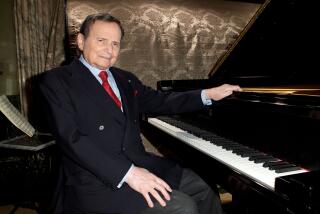Alexei Lubimov takes on unconventional program at Colburn School
Two years ago Alexei Lubimov, the peculiar Russian polymath pianist, made a rare appearance in Los Angeles to open the season of Monday Evening Concerts at the Colburn School’s Zipper Concert Hall. He was back Monday to do the same. He proved no less strange this time around.
Lubimov’s program on Monday began with Satie and ended with Debussy, not a big stretch, it might seem, the two French composers having been friends and having influenced each other. In between came three short prepared piano pieces by John Cage from the 1940s that were written at a time when Satie was much on Cage’s mind.
The odd composer out, and odd hardly begins to describe the crazy-amazing music of Alexandre Rabinovitch-Barakovsky, was the bigger news of the evening. The Baku-born Rabinovitch-Barakovsky is best known as a frequent pianist partner of Martha Argerich, as well as the conductor in some of her concerto recordings.
But he is also a mystically inclined Minimalist composer with a cult following in Europe, where he has been based since the mid ‘70s. The Soviet Union would have been unsympathetic to any budding Slavic Philip Glass or Steve Reich, let alone a composer even less conventional and far weirder than they.
The Rabinovitch-Barakovsky piece that Lubimov — who had his own problems with the Moscow authorities in the ‘70s for his avant-garde activities — selected was “Récit de Voyage” (Story of a Journey), for piano, violin, cello and percussion. Although an early piece written in 1976 (the year of Glass’ “Einstein on the Beach”), this was a U.S. premiere. In his program note, Rabinovitch-Barakovsky says the quartet reflects his metaphysical, musical and physical journey after leaving the Soviet Union.
Spiritually, this traveler leaves the land of the Gospel According to St. Luke and discovers the Buddhist “Lotus Sutra.” Musically, he is the Schubert of the “Wanderer” Sonata zooming through the worm hole of Wagner’s “Tristan” and coming out into an alternative universe.
You can tell Rabinovitch-Barakovsky’s music from the first few seconds. The harmonies are sticky sweet. Bells toll and there tend to be arpeggios and manically repeated figures. Strings slide and tremble. The direction keeps changing. The ground under your feet, if you are susceptible to this kind of thing, becomes unsteady and your mind reels.
For this performance, violinist Movses Pogossian and cellist Karen Ouzounian had plenty of slipping and sliding and trembling to do as they wiggled their way up and down, up and down, the scale. Percussionist Jonathan Hepfer and Lubimov added pulse and glitter and the pealing of bells that startled the senses.
Rabinovitch-Barakovsky is practically unknown in the U.S. (few of his recordings are imported here but some can be found online). His later music includes big, mystical orchestral pieces that knock your sonic socks off and, to my knowledge, have never been done by a major orchestra. What is the Los Angeles Philharmonic waiting for?
Lubimov began his program with equally rare, mystical and Minimalist Satie — the first prelude and act from composer’s incidental music to a late 19th century Rosicrucian mystery play “Le Fils de Étoile” (The Son of the Stars). This, too, was an early work and a U.S. premiere. For more than 20 minutes, Satie patiently sticks to a few chords and ideas that create a luminous atmosphere. Lubimov, who has a full recording of the work coming out next year, played with a ringing tone and loving application of tonal coloration.
A constancy in Lubimov’s playing is his big Russian sound, and that was intriguingly noticeable when he played Cage’s “Prelude for Meditation, “Music for Marcel Duchamp” and “The Perilous Night,” with much attention to resonance, on the prepared piano. In Debussy, Lubimov’s Russian character proved even more startling.
He played six from the dozen of the Second Book of Preludes, giving them the hardy transcendence of Scriabin along with the rhythmic spirit of Stravinsky. Full of character, each prelude seemed as intoxicating as a shot of vodka. After six, you’re drunk. But there were two more as encores, including the “Sunken Cathedral” from the First Book that filled Zipper and seemed to reverberate longer than possible.
Lubimov’s two new ECM recordings are devoted to Cage and Debussy’s Preludes. They’re heady stuff. Don’t listen and drive. And that goes double for any recording you can get your hands on of Rabinovitch -Barakovsky.
MORE:
CRITIC’S PICKS: Fall Arts Preview
TIMELINE: John Cage’s Los Angeles
PHOTOS: Arts and culture in pictures
More to Read
The biggest entertainment stories
Get our big stories about Hollywood, film, television, music, arts, culture and more right in your inbox as soon as they publish.
You may occasionally receive promotional content from the Los Angeles Times.







